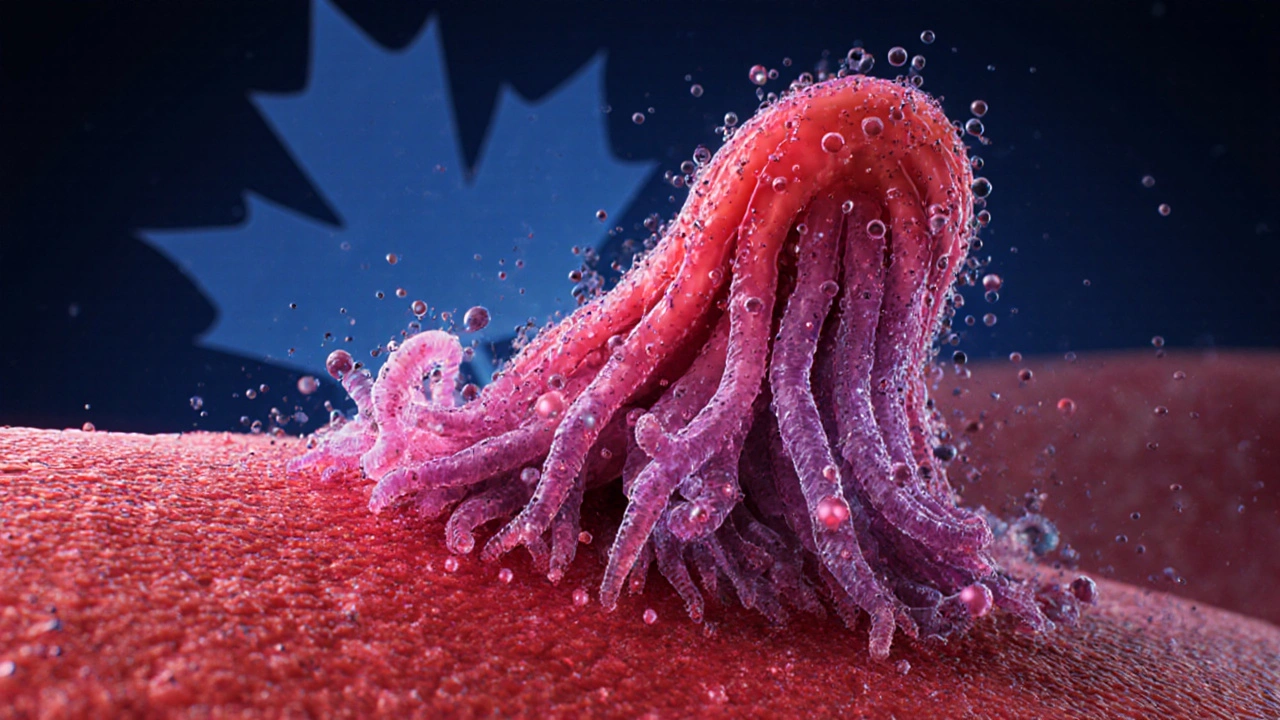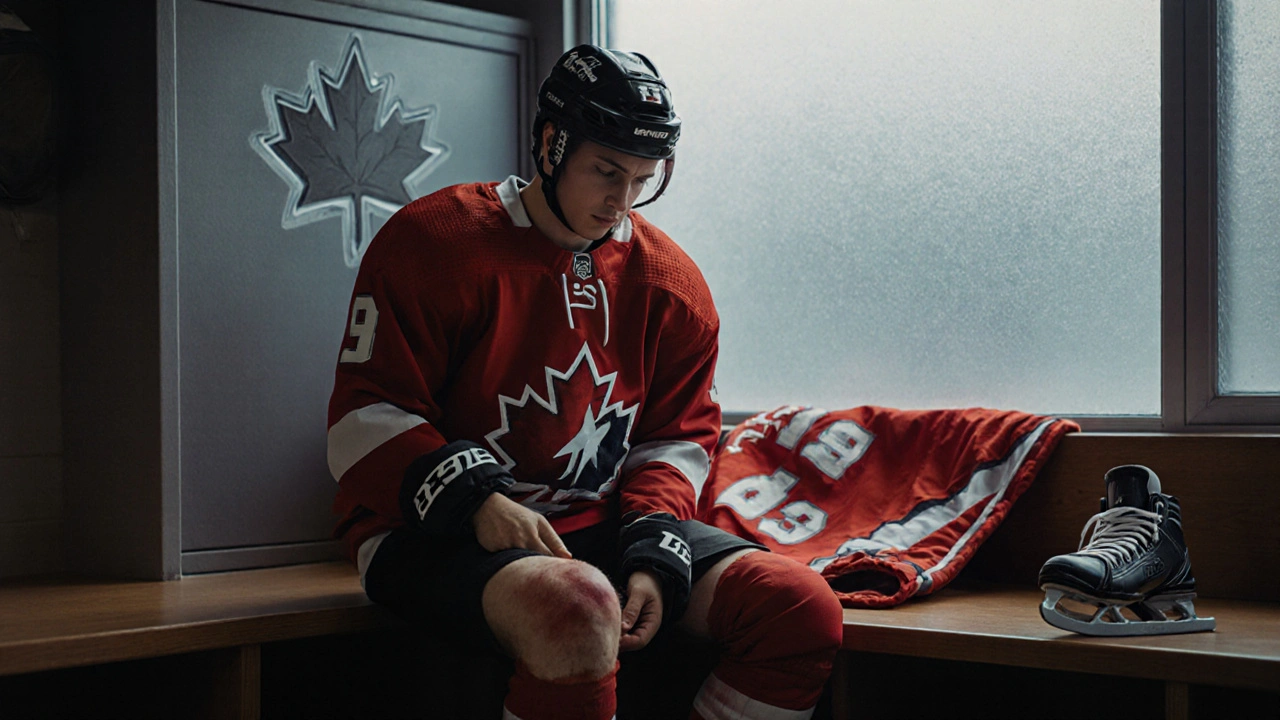Jock Itch Knowledge Quiz
1. What is the main cause of jock itch?
2. Which part of the body is typically affected by jock itch?
3. How long should you use antifungal cream for jock itch?
4. Which of the following can help prevent jock itch?
When the skin in the groin area turns red, itchy, and scaly, many people are dealing with jock itch - a common fungal infection also called tinea cruris. It thrives in warm, moist environments and can spread quickly if left untreated.
Quick Take
- Caused mainly by dermatophyte fungi that love heat and sweat.
- Early signs: red border, itching, and a flaky rash in the groin, inner thighs, or buttocks.
- OTC antifungal creams work for most mild cases.
- Severe or recurrent cases may need prescription pills or stronger topical meds.
- Keeping the area dry, clean, and ventilated prevents recurrence.
What actually causes jock itch?
The main culprits are dermatophyte fungi-tiny organisms that live on skin, hair, and nails. The most common species are Trichophyton rubrum and Trichophyton mentagrophytes. They break down keratin, the protein that makes up the outer layer of skin, which is why they love the soft, moist folds of the groin.
Several factors create a perfect breeding ground:
- Excess moisture: Sweat from workouts, hot weather, or tight underwear traps humidity.
- Friction from sports gear or poorly fitting clothes damages the skin barrier.
- Sharing towels, shoes, or gym equipment spreads spores.
- Weak immune response, diabetes, or obesity increase susceptibility.
While dermatophytes are the primary cause, other microbes like Candida yeast can join the party, especially if the area stays damp for days.
Spotting the symptoms
Jock itch usually starts as a small, pinkish patch that quickly expands. Look for these tell‑tale signs:
- Itchy, burning sensation that worsens after exercise or a hot shower.
- Red or brown border that may be slightly raised.
- Fine scaling or flaking inside the rash.
- Occasional blisters that break open and ooze.
The rash often spares the genitalia itself, staying limited to the crease where the thigh meets the pelvis.
How doctors confirm the diagnosis
Most cases are obvious enough for a visual exam. In uncertain situations, a clinician may:
- Take a skin scraping and examine it under a microscope to spot fungal hyphae.
- Culture the sample on a special agar to identify the exact species.
- Use a Wood's lamp (UV light) - some fungi glow green.
These tests help rule out bacterial infections, eczema, or psoriasis, which can look similar.

Treatment options that actually work
Most mild cases clear up in two weeks with proper over‑the‑counter antifungal creams. Here’s a breakdown of the main approaches:
| Option | Typical Use | Pros | Cons |
|---|---|---|---|
| OTC antifungal cream | Apply twice daily for 2‑4 weeks | Easy, inexpensive, low side‑effects | May not work for extensive or resistant infections |
| Prescription oral antifungal | Take daily for 2‑6 weeks (e.g., terbinafine, itraconazole) | Reaches fungus under the skin, faster resolution | Potential liver toxicity, requires doctor’s approval |
| Prescription topical steroid + antifungal combo | Used for inflamed, itchy rashes | Reduces inflammation while killing fungus | Long‑term steroid use can thin skin |
| Home‑care measures | Daily hygiene, moisture‑wicking clothing | No cost, supports any medical treatment | Requires discipline, slower effect alone |
OTC antifungal creams
Look for active ingredients like clotrimazole, miconazole, or terbinafine. Apply a thin layer after washing and drying the area. Remember: the cream must stay on the skin for the full treatment period, even if symptoms disappear early.
Prescription oral antifungals
When the rash is large, recurs often, or doesn’t respond to creams, doctors may prescribe pills. These medications travel through the bloodstream, reaching the fungus wherever it hides. Typical courses last 2‑6 weeks, and a blood test may be ordered to confirm liver health before starting.
Combination creams (antifungal + steroid)
If itching is intense, a low‑strength steroid (like hydrocortisone 1%) mixed with an antifungal can calm the skin while the drug does its job. Use for no more than two weeks to avoid thinning.
Home‑care measures that speed recovery
Good hygiene is a game‑changer. Here’s a simple routine:
- Shower daily; after a workout, rinse off sweat within an hour.
- Pat the groin dry with a clean towel; avoid rubbing, which can irritate.
- Apply a cotton‑based powder or a spray containing antifungal powder to keep moisture at bay.
- Swap to loose, breathable underwear made of cotton or moisture‑wicking synthetic blends.
- Never reuse gym towels; wash them in hot water after each use.
For athletes, a quick‑dry, antimicrobial shirt can reduce friction and sweat buildup.
Preventing future flare‑ups
Even after the rash clears, the fungus can linger on clothing or skin. Use these habits to stay ahead:
- Wash underwear, gym shorts, and socks in hot water (≥60°C) and dry on high heat.
- Apply a thin layer of antifungal powder after each wash, especially during summer.
- Avoid tight waistbands or compression shorts that trap heat.
- Keep the groin area ventilated; consider brief periods of “air time” during the day.
When to see a healthcare professional
If you notice any of these red flags, book an appointment:
- Rash spreading to the abdomen or genitals.
- Painful sores that don't improve after a week of OTC treatment.
- Recurring infections despite proper hygiene.
- Signs of a bacterial infection: pus, increased warmth, fever.
A clinician can prescribe stronger meds or run tests to rule out other skin conditions.
Key takeaways
Understanding the root cause, spotting symptoms early, and following a consistent treatment plan can clear jock itch in most cases. Pairing medication with good hygiene and moisture control cuts the chance of a comeback.
Frequently Asked Questions
Can jock itch spread to other parts of the body?
Yes. The fungal spores can travel to the feet (causing athlete’s foot) or the scalp (causing ringworm). Treating the original area while keeping other skin clean helps stop spread.
Is it safe to use the same antifungal cream for both jock itch and athlete’s foot?
Generally, yes. Many OTC creams contain broad‑spectrum agents that work on both conditions. Just apply each area as directed and avoid cross‑contamination by washing hands.
How long does it take for a rash to disappear?
With proper treatment, mild cases improve within 5‑7 days, but the full course should be completed for 2‑4 weeks to prevent recurrence.
Can women get jock itch?
Absolutely. Though the term originates from male athletes, anyone with warm, moist skin folds-women included-can develop the infection.
Is shaving the groin area a good idea?
Shaving can create micro‑cuts that let fungi enter, worsening the rash. If you prefer hair removal, opt for a trimmed, not shaved, look or use a gentle depilatory cream after the infection clears.


Renee van Baar
September 29, 2025 AT 19:26Keep it dry and the itch will quit.
Mithun Paul
October 7, 2025 AT 23:26From an epidemiological perspective, the predominance of Trichophyton species underscores the necessity of rigorous hygiene protocols; neglecting such measures invariably precipitates dermatophytic proliferation.
Sandy Martin
October 16, 2025 AT 03:26I totally get how uncomfortable it can be-make sure you drier the area after showering and appli a thin layer of antifungal cream daily, it really helps.
Steve Smilie
October 24, 2025 AT 07:26Behold, the saga of fungal insurrection in one's nethermost realms-a veritable tapestry woven with keratinous threads, demanding both sartorial elegance and biomedical acumen.
barry conpoes
November 1, 2025 AT 11:26Listen up, folks: stop wearing those skinny briefs and start treating this infection like a battlefield-victory belongs to the well‑ventilated.
Kristen Holcomb
November 9, 2025 AT 15:26First, understand that jock itch thrives in moisture, so the foundation of any treatment is keeping the groin dry.
Second, daily showers followed by thorough pat‑drying can dramatically reduce fungal growth.
Third, choose underwear made from breathable cotton or moisture‑wicking synthetics rather than restrictive synthetic blends.
Fourth, applying an over‑the‑counter antifungal cream with clotrimazole or terbinafine twice daily ensures the medication reaches the affected keratin.
Fifth, continue the regimen for at least two weeks even if symptoms fade, because premature cessation often leads to relapse.
Sixth, for recurrent cases, consider rotating to a different class of antifungal to avoid resistance.
Seventh, if the rash spreads beyond the groin to the abdomen or genitals, seek medical evaluation promptly.
Eighth, dietary factors such as excessive sugar can feed Candida, so moderating intake may support recovery.
Ninth, regular laundering of gym clothes in hot water (≥60 °C) eliminates lingering spores.
Tenth, applying a talc‑free powder after showering can absorb residual moisture throughout the day.
Eleventh, avoid sharing towels, socks, or shoes with others to curb transmission.
Twelfth, if you notice painful sores or pus, suspect a secondary bacterial infection and consult a clinician.
Thirteenth, prescription oral antifungals like terbinafine are highly effective for extensive infections, but monitor liver function as advised.
Fourteenth, steroid‑antifungal combo creams can alleviate intense itching while treating the fungus, yet limit use to two weeks to prevent skin thinning.
Fifteenth, maintaining a balanced lifestyle with regular exercise and proper hydration supports overall immune health, indirectly combating fungal overgrowth.
Sixteenth, remember that persistence and consistency are key-once the fungus is eradicated, vigilance will keep it from returning.
justin davis
November 17, 2025 AT 19:26Wow, another fungus party in the groin-who knew sweating could be so exciting!!! Grab that cream, slap it on, and maybe, just maybe, you’ll stop itching like a madman!!!
David Lance Saxon Jr.
November 25, 2025 AT 23:26While the presented regimen is commendably exhaustive, one must contemplate the ontological interplay between epidermal keratin matrices and fungal hyphal incursion, thereby recognizing that mere topical applications constitute a phenomenological veneer over a deeper mycotic dialectic.
Moore Lauren
December 4, 2025 AT 03:26Pro tip: keep the area clean, dry, and use a good antifungal cream for a couple of weeks.